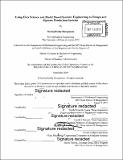| dc.contributor.advisor | Kamal Youcef-Toumi and Arnold I. Barnett. | en_US |
| dc.contributor.author | Kanapuram, Ravitej Reddy. | en_US |
| dc.contributor.other | Sloan School of Management. | en_US |
| dc.contributor.other | Massachusetts Institute of Technology. Department of Mechanical Engineering. | en_US |
| dc.contributor.other | Leaders for Global Operations Program. | en_US |
| dc.date.accessioned | 2020-02-10T21:41:24Z | |
| dc.date.available | 2020-02-10T21:41:24Z | |
| dc.date.issued | 2019 | en_US |
| dc.identifier.uri | https://hdl.handle.net/1721.1/123750 | |
| dc.description | Thesis: S.M., Massachusetts Institute of Technology, Department of Mechanical Engineering, in conjunction with the Leaders for Global Operations Program at MIT, 2019 | en_US |
| dc.description | Thesis: M.B.A., Massachusetts Institute of Technology, Sloan School of Management, in conjunction with the Leaders for Global Operations Program at MIT, 2019 | en_US |
| dc.description | "September 2019." Cataloged from PDF version of thesis. | en_US |
| dc.description | Includes bibliographical references (pages 69-70). | en_US |
| dc.description.abstract | Over the last several decades, products and the production systems within the aerospace industry have grown increasingly complex -- | en_US |
| dc.description.abstract | a natural result of the continuous inclusion of technological advancements to expand the set of features of the systems. Furthermore, design of the production system has historically taken a backseat to the design of the airplane. Modifications to the production systems have thus had to be made after implementation, causing significant delays and additional expenditures. In an effort to halt this trend, prevent some of the inefficiencies from past programs from repeating, and ensure the economic viability of its products, Boeing is exploring how to take a holistic approach and effectively integrate production system design earlier in the program timeline. The primary goal of this research is to investigate how data science and model-based systems engineering (MBSE) can be used to better design and operate production systems. Namely, this work explores how these two methodologies can be used to construct a digital representation of the production system (i.e. "digital twin"), which can in turn be utilized to run stochastic simulations to more accurately characterize how a given production system configuration will perform when the constituent elements themselves behave as random variables. | en_US |
| dc.description.abstract | This project is specifically focused on modeling and evaluating a representative portion of the production system, fuselage lamination, which is the process by which layers of carbon-fiber-reinforced-polymer (CFRP) are built-up on mandrels to form the various composite sections of the airplane fuselage prior to being cured in autoclaves. Namely, three different production line configurations responsible for fuselage lamination were compared. It was found that for this particular process, the most effective configuration was not that which would have been chosen based on industry principles. | en_US |
| dc.description.abstract | A second objective of this study is to abstract the learnings from this specific implementation to the broader data science and MBSE architecture required to more intelligently design and operate production systems. It is my hope that this work will help demystify the significance of a "digital twin" by providing a concrete example of its use, and garner support for the methodology within organizations by providing clarity on its development requirements, shedding light on the business case for implementation, and offering guidance on how models can be built and used as major levers in developing the premier production system within the industry. Specifically, it hopefully serves as a demonstration of how a detailed, digital representation of the production system can address the issues arising from complexity and enable further system capabilities throughout the lifecycle of the system by offering additional means to effectively build and test concepts in silico. | en_US |
| dc.description.statementofresponsibility | by Ravitej Reddy Kanapuram. | en_US |
| dc.format.extent | 70 pages | en_US |
| dc.language.iso | eng | en_US |
| dc.publisher | Massachusetts Institute of Technology | en_US |
| dc.rights | MIT theses are protected by copyright. They may be viewed, downloaded, or printed from this source but further reproduction or distribution in any format is prohibited without written permission. | en_US |
| dc.rights.uri | http://dspace.mit.edu/handle/1721.1/7582 | en_US |
| dc.subject | Sloan School of Management. | en_US |
| dc.subject | Mechanical Engineering. | en_US |
| dc.subject | Leaders for Global Operations Program. | en_US |
| dc.title | Using data science and model based systems engineering to design and operate production systems | en_US |
| dc.type | Thesis | en_US |
| dc.description.degree | S.M. | en_US |
| dc.description.degree | M.B.A. | en_US |
| dc.contributor.department | Sloan School of Management | en_US |
| dc.contributor.department | Massachusetts Institute of Technology. Department of Mechanical Engineering | en_US |
| dc.contributor.department | Leaders for Global Operations Program | en_US |
| dc.identifier.oclc | 1138947533 | en_US |
| dc.description.collection | S.M. Massachusetts Institute of Technology, Department of Mechanical Engineering | en_US |
| dc.description.collection | M.B.A. Massachusetts Institute of Technology, Sloan School of Management | en_US |
| dspace.imported | 2020-02-10T21:41:23Z | en_US |
| mit.thesis.degree | Master | en_US |
| mit.thesis.department | MechE | en_US |
| mit.thesis.department | Sloan | en_US |
